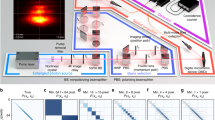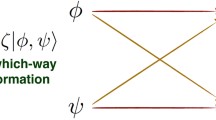Abstract
We clarify different definitions of the density matrix by proposing the use of different names, the full density matrix for a single-closed quantum system, the compressed density matrix for the averaged single molecule state from an ensemble of molecules, and the reduced density matrix for a part of an entangled quantum system, respectively. We show that ensembles with the same compressed density matrix can be physically distinguished by observing fluctuations of various observables. This is in contrast to a general belief that ensembles with the same compressed density matrix are identical. Explicit expression for the fluctuation of an observable in a specified ensemble is given. We have discussed the nature of nuclear magnetic resonance quantum computing. We show that the conclusion that there is no quantum entanglement in the current nuclear magnetic resonance quantum computing experiment is based on the unjustified belief that ensembles having the same compressed density matrix are identical physically. Related issues in quantum communication are also discussed.
Similar content being viewed by others
References
von Neumann J. (1927). “Thermodynamik quantenmechanischer Gesamtheit”. Goettinger. Nachr. 245, 273
Landau L. (1927). “Das Dämpfungsproblem in der Wellenmechanik”. Z. Phys. 45, 430
Ashe Peres (1998). Quantum Theory: Concepts and Methods. Kluwer Academic, Dordrecht
Preskill J. (1998). Lecture Notes for Physic 229: Quantum Information and Computation. California Institute of Technology, CA
d’Espagnat B. (1995). Veiled Reality: an Analysis of Present-Day Quantum Mechanical Concepts. Addison-Wesley, Reading, MA
Fano U. (1957). “Description of states in quantum mechanics by density matrix and operator techniques”. Rev. Mod. Phys. 29, 74
Ka Xinglin (2001). Advanced Quantum Mechanics (in Chinese), 2nd edn. Higher Education Press, Beijing
Ref. 3, pp. 75–76.
Shankar R. (1980) Principles of Quantum Mechanics. Plenum, New York, p. 140
Merzbacher E. (1970). Quantum Mechanics, 2nd edn. Wiley, New York
von Neumann J. (1955) Mathematical Foundations of Quantum Mechanics. Princeton University Press, Princeton, pp. 295–296
R. K. Pathria, Statistical Mechanics, 2nd edn. (Elsevier (Singapore), Singapore, 2001), pp. 4–45.
C. H. Bennett and G. Brassard, “Quantum cryptography: public key distribution and coin tossing,” Proceedings IEEE Int. Conference on Computers, Systems and Signal Processing, Bangalore, India (IEEE, New York, 1984), pp. 175–179.
Cohen O. (1999). “Counterfactual entanglement and nonlocal correlations in separable states”. Phys. Rev. A 60, 80
Yang C.N. (1962). “Concept of off-diagonal long-range order and the quantum phases in liquid He and of superconductors”. Rev. Mod. Phys. 34, 694
Schliemann J., Loss D., MacDonald A.H. (2001). “Double-occupancy errors, adiabaticity, and entanglement of spin qubits in quantum dots”. Phys. Rev. B 63, 085311
Li Y.S., Zeng B., Liu X.S., Long G.L. (2001). “Entanglement in a two-identical-particle system”. Phys. Rev. A 64, 054302
Long G.L., Xiao L. (2003). “Experimental realization of a fetching algorithm in a 7-qubit NMR Liouville space computer”. J. Chem.Phys. 119: 8473
Wang C., Long G.L., Sun Y. (2005). “No-relationship between impossibility of faster-than-light quantum communication and distinction of ensembles with the same density matrix”. Commun. Theor. Phys. 44, 622
Penrose R., Shimony A., Cartwright N., Hawking S. (1997) The Large, the Small and The Human Mind. Cambridge University Press, Cambridge, p. 81
Exercise 2.1 (and 2.3) on p. 32 of Peres’s book.
Braunstein S.L., Caves C.M., Jozsa R., Linden N., Popescu S., Schack R. (1999). “Separability of very noisy mixed states and implications for NMR quantum computing”. Phys. Rev. Lett. 83: 1054
Long G.-L., Yan H.-Y. et al. (2002). “Quantum mechanical nature in NMR quantum computing”. Commun. Theor. Phys. 38, 306
J. Tolar and P. Hàjìček, “Can differently prepared mixed states be distinguished?,” quant-ph/0309158.
N. A. Gershenfeld and I. L. Chuang, “Bulk spin-resonance quantum computation,” Science, 275, 350 (1997). Especially see the explanation under Eq. (3).
Slichter C.P. (1990) Principles of Magnetic Resonance, 3rd edn Springer, Berlin Heidelberg, p. 159
Author information
Authors and Affiliations
Corresponding author
Rights and permissions
About this article
Cite this article
Long, G.L., Zhou, YF., Jin, JQ. et al. Density Matrix in Quantum Mechanics and Distinctness of Ensembles Having the Same Compressed Density Matrix. Found Phys 36, 1217–1243 (2006). https://doi.org/10.1007/s10701-006-9057-9
Received:
Revised:
Published:
Issue Date:
DOI: https://doi.org/10.1007/s10701-006-9057-9




